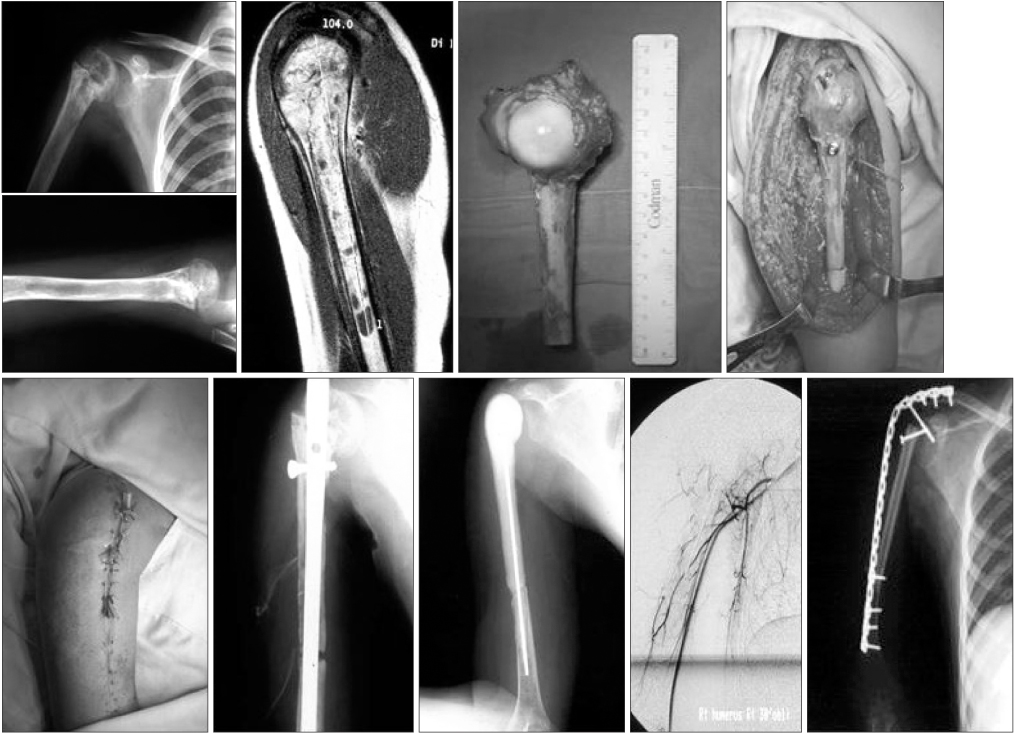J Korean Orthop Assoc.
2016 Oct;51(5):418-425. 10.4055/jkoa.2016.51.5.418.
Results of Clinical and Oncological Outcomes in Treatment of the Humerus Malignant Bone Tumor: Comparison according to the Treatment Methods
- Affiliations
-
- 1Department of Orthopedic Surgery, Yeungnam University Medical Center, Daegu, Korea. redpross@naver.com
- KMID: 2355507
- DOI: http://doi.org/10.4055/jkoa.2016.51.5.418
Abstract
- PURPOSE
The purpose of this study was to compare the clinical and oncological outcomes between the primary and metastatic malignant tumor of humerus.
MATERIALS AND METHODS
Between May 2005 and May 2014, 42 cases of malignant tumor in humerus that were followed-up for at least 1 year were entered into the study and analyzed retrospectively. Cases were divided into two groups, the primary (group 1, 15 cases) and metastatic (group 2, 27 cases), according to the origin of the tumor. The clinical and oncological outcomes between the primary and metastatic malignant tumor of humerus were analyzed and compared.
RESULTS
In the group 1, nine cases were osteosarcoma and six cases were chondrosarcoma. The tumor lesions were distributed in the proximal area of the humerus. In the group 2, 12 cases originated from lung cancer, six cases from liver cancer, and two cases from bladder cancer. The lesions were usually distributed in the midshaft area. The patients underwent various surgical treatments, including wide excision with tumor prosthesis, curettage with bone grafting, intramedullary nailing, open reduction, and internal fixation with plate. Kaplan-Meier 5-year survival estimates were 87.5% for group 1, and 1-year survival estimates were 70.1% and 2-year survival estimates were 40.1% for group 2. The mean Musculoskeletal Tumor Society score was high in both groups. However group 1 showed a higher score on the functional index compared to group 2.
CONCLUSION
Primary malignant bone tumors of the humerus usually involve the proximal site and tumor prosthesis is the main treatment. The metastatic malignant bone tumor usually involves the midshaft area and intramedullary nailing and radiation therapy is the main therapy. Although treatment of the primary malignant tumor increases the survival rate, treatment of metastatic malignant tumor does not affect the survival rate, though it helps in relieving pain.
Keyword
MeSH Terms
Figure
Reference
-
1. Dahlin DC. one tumors: general aspects and data on 6,221 cases. 3rd ed. Springfield: Charles C. Thomas Publisher;1978.2. Taylor GM. Tumor of the right humerus. Proc Mine Med Off Assoc. 1967; 46:122–123.3. Teunis T, Nota SP, Hornicek FJ, Schwab JH, Lozano-Calderón SA. Outcome after reconstruction of the proximal humerus for tumor resection: a systematic review. Clin Orthop Relat Res. 2014; 472:2245–2253.
Article4. Akahoshi Y, Doi S, Yonezawa H, Tanaka S, Kuwana K. Segmental resection with prosthetic replacement for malignant bone tumor of the humerus. Nihon Geka Hokan. 1965; 34:739–746.5. De Wilde LF, Van Ovost E, Uyttendaele D, Verdonk R. Results of an inverted shoulder prosthesis after resection for tumor of the proximal humerus. Rev Chir Orthop Reparatrice Appar Mot. 2002; 88:373–378.6. Li D, Zhang Z, Huang M. Prosthesis replacement of proximal humerus after resection of malignant tumor. Zhongguo Xiu Fu Chong Jian Wai Ke Za Zhi. 2006; 20:996–998.7. Damron TA, Sim FH. Surgical treatment for metastatic disease of the pelvis and the proximal end of the femur. Instr Course Lect. 2000; 49:461–470.8. Swanson KC, Pritchard DJ, Sim FH. Surgical treatment of metastatic disease of the femur. J Am Acad Orthop Surg. 2000; 8:56–65.
Article9. Liu T, Zhang Q, Guo X, Zhang X, Li Z, Li X. Treatment and outcome of malignant bone tumors of the proximal humerus: biological versus endoprosthetic reconstruction. BMC Musculoskelet Disord. 2014; 15:69.
Article10. Janssen SJ, Teunis T, Hornicek FJ, Bramer JA, Schwab JH. Outcome of operative treatment of metastatic fractures of the humerus: a systematic review of twenty three clinical studies. Int Orthop. 2015; 39:735–746.
Article11. Wedin R, Hansen BH, Laitinen M, et al. Complications and survival after surgical treatment of 214 metastatic lesions of the humerus. J Shoulder Elbow Surg. 2012; 21:1049–1055.
Article12. Enneking WF, Dunham W, Gebhardt MC, Malawar M, Pritchard DJ. A system for the functional evaluation of reconstructive procedures after surgical treatment of tumors of the musculoskeletal system. Clin Orthop Relat Res. 1993; 286:241–246.
Article13. Haggart GE. The treatment of primary malignant bone tumors of the humerus. Surg Clin North Am. 1947; 27:717–728.
Article14. Shenoy R, Pillai A, Sokhi K, Porter D, Ried R. Survival trends in osteosarcoma of humerus. Eur J Cancer Care (Engl). 2008; 17:261–269.
Article15. Wittig JC, Bickels J, Kellar-Graney KL, Kim FH, Malawer MM. Osteosarcoma of the proximal humerus: long-term results with limb-sparing surgery. Clin Orthop Relat Res. 2002; 397:156–176.
Article16. Guven MF, Aslan L, Botanlioglu H, Kaynak G, Kesmezacar H, Babacan M. Functional outcome of reverse shoulder tumor prosthesis in the treatment of proximal humerus tumors. J Shoulder Elbow Surg. 2016; 25:e1–e6.
Article17. Viehweger E, Gonzalez JF, Launay F, Legre R, Jouve JL, Bollini G. Shoulder arthrodesis with vascularized fibular graft after tumor resection of the proximal humerus. Rev Chir Orthop Reparatrice Appar Mot. 2005; 91:523–529.18. Yadav P, Thakkar D, Thind SS. Intramedullary chondrosarcoma of proximal humerus. Case Rep Radiol. 2012; 12. 2. Published online. DOI: 10.1155/2012/642062.
Article19. Bertoni F, Present D, Picci P, Bacchini P. Case report 301. Diagnosis: dedifferentiated chondrosarcoma of the upper end of the humerus. Skeletal Radiol. 1985; 13:228–232.20. Frassica FJ, Frassica DA. Metastatic bone disease of the humerus. J Am Acad Orthop Surg. 2003; 11:282–288.
Article21. Sennerich T, Kurock W, Ritter G. Intramedullary bundle nailing for stabilization of pathologic humerus fractures in malignant tumors. Z Orthop Ihre Grenzgeb. 1989; 127:68–71.22. Bashore CJ, Temple HT. Management of metastatic lesions of the humerus. Orthop Clin North Am. 2000; 31:597–609.
Article
- Full Text Links
- Actions
-
Cited
- CITED
-
- Close
- Share
- Similar articles
-
- Reconstructive surgery in primary malignant and aggressive benign bone tumor of the proximal humerus
- Homogenous Osteoarticular Transplantation of the Proximal Humerus: Report of A Case
- Malignant Osteoblastoma: A Case Report
- Pathologic Fracture Due to an Osteoblastoma of the Humerus Shaft: A Case Report
- Treatment of malignant bone tumor: limb salvage surgery using metallic tumor prosthesis







